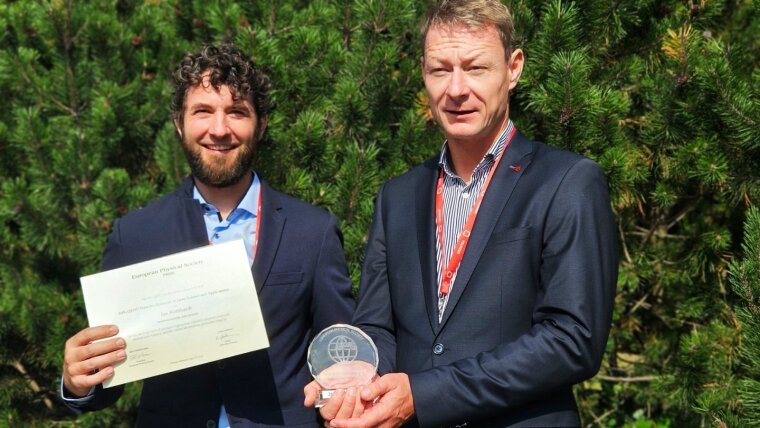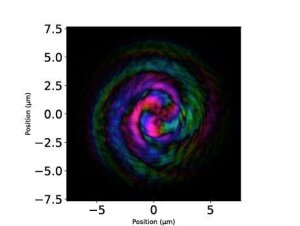
- Light
- Forschung
Published: | By: Ira Winkler
High-resolution image of a generated and measured EUV Vortex beam. Alongside the powerful EUV light sources, it is the key to high-resolution EUV imaging. The brightness represents the amplitude and the color the phase of the EUV light field.
Image: W. EschenThis prestigious award is presented every two years by the Division of Quantum Electronics and Optics of the European Physical Society (EPS) and recognizes outstanding contributions in the field of laser technology. The award ceremony will take place on August 27, 2024 during the 11th Europhoton conference in Vilnius, Lithuania.
Technical innovation
In close collaboration, Professor Dr. Jens Limpert and Dr. Jan Rothhardt have developed new understanding and technologies to realize EUV sources with synchrotron-like performance. By using high-power femtosecond fiber laser systems and the concept of coherently combining multiple fiber amplifiers, they have developed highly harmonic sources with high conversion efficiency whose photon flux exceeds the state of the art by several orders of magnitude.
Their work leads to a groundbreaking new technology: a high-resolution, lensless EUV microscope using the ptychography method. This method enables an unprecedented resolution of 16 nanometers and provides quantitative amplitude and phase information in every image pixel. This unlocks unexploited potential in nanoscience and materials science, such as in the development of efficient nanoelectronics, for energy and data storage devices, as well as in biological imaging, with applications ranging from cancer cell detection through to studying the interaction of pathogens, drugs or nanoparticles with biological cells.
Successful collaboration
The outstanding achievements were made possible by close inter-institutional collaboration between the two researchers. Professor Limpert — member of the of the directorate at the Fraunhofer Institute for Applied Optics and Precision Engineering (IOF) and Professor at the Institute of Applied Physics at the Friedrich Schiller University Jena — and Privatdozent Dr. Rothhardt — Research Group Leader at the Helmholtz Institute Jena, a branch of GSI Helmholtzzentrum für Schwerionenforschung in Darmstadt — combined their expertise in laser technology and imaging techniques to develop this innovative technology.
Their work impressively demonstrates how significant scientific breakthroughs can be achieved through teamwork and cooperation. Professor Limpert emphasized: “The interdisciplinary collaboration has enabled us to create a compact EUV microscope on a laboratory scale and demonstrate it on microorganisms. This not only expands the application possibilities, but also makes the technology more accessible.” "The award is the highlight of this overall achievement and we are delighted to accept the prize on behalf of the team," concludes Dr. Rothhardt.
The Helmholtz Institute Jena, the Friedrich Schiller University Jena and the Fraunhofer IOF warmly congratulate Professor Dr. Jens Limpert and Dr. Jan Rothhardt on this outstanding award and look forward to the further scientific successes that will result from their pioneering research.
